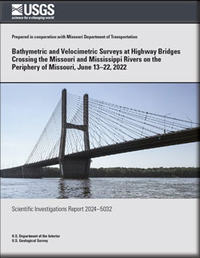Bathymetric and Velocimetric Surveys at Highway Bridges Crossing the Missouri and Mississippi Rivers on the Periphery of Missouri, June 13–22, 2022
Links
- Document: Report (36 MB pdf) , HTML , XML
- Dataset: USGS National Water Information System database —USGS water data for the Nation
- Data Release: USGS data release - Bathymetry and velocity data from surveys at highway bridges crossing the Missouri and Mississippi Rivers on the periphery of Missouri, June 13–22, 2022
- Download citation as: RIS | Dublin Core
Abstract
Bathymetric and velocimetric data were collected by the U.S. Geological Survey, in cooperation with the Missouri Department of Transportation, near seven bridges at six highway crossings of the Missouri and Mississippi Rivers on the periphery of Missouri from June 13–22, 2022. A multibeam echosounder mapping system was used to obtain channel-bed elevations for river reaches about 1,640 feet longitudinally and generally extending laterally across the active channel from bank to bank during minor flood-flow conditions. These surveys provided channel geometry and hydraulic conditions at the time of the surveys and provided characteristics of scour holes that may be useful in developing or verifying predictive guidelines or equations for computing potential scour depth. These data also may be useful to the Missouri Department of Transportation as a minor flood-flow assessment of the bridges for stability and integrity issues with respect to bridge scour during floods.
Bathymetric data were collected around every in-channel pier. Scour holes were present at most piers for which bathymetry could be obtained, except those on banks or surrounded by riprap. Occasionally, scour holes were minor and difficult to discern from nearby dunes and ripples. All bridge sites in this study were surveyed and documented in previous studies. Although partial exposure of substructural support elements was observed at several piers, at most sites the exposure most likely is minimal compared to the overall substructure that remains buried in bed material at these piers. The notable exceptions are piers 12 and 13 at structure L0135 on State Highway 51 at Chester, Illinois, where the bedrock material was fully exposed around the piers.
The average difference between the bathymetric surfaces between 2022 and 2018 varied from 0.41 foot higher to 1.86 feet lower. Between 2022 and 2014, the average difference between the bathymetric surfaces varied from 1.02 feet higher to 4.69 feet lower. Only the two sites on the Missouri River and the Caruthersville site were surveyed in 2011; for those sites, the average difference between the bathymetric surfaces varied from 5.83 feet higher to 1.34 feet lower. The most substantial overall net gain of sediment in a reach was between 2011 and 2022 at structure A1700 near Caruthersville, Mo. (site 38). This result was expected because structure A1700 is downstream from the confluences of the Missouri and Ohio Rivers, and therefore subject to the largest streamflows, the largest streamflow fluctuations, and the most substantial sediment flux, as has historically been observed at this site.
The presence of riprap blankets, pier size and nose shape, and alignment to flow had a substantial effect on the size of the scour hole observed for a given pier. Piers that were surrounded by riprap blankets had scour holes that were substantially smaller (to nonexistent) compared to piers at which no rock or riprap were present. New riprap blankets were surveyed at pier 3 of structure L0098 at Brownville, Nebraska, and at piers 15–18 of structure A1700 near Caruthersville, Mo., that effectively mitigated the scour holes historically observed at these piers. Narrow piers having round or sharp noses that were aligned with flow often had scour holes that were difficult to discern from nearby bed features, whereas piers having wide or blunt noses resulted in larger, deeper scour holes. Several of the structures had piers that were skewed to primary approach flow. Scour holes near these piers consistently displayed greater depth on the side of the pier with impinging flow and deposition on the leeward side of the pier.
Suggested Citation
Huizinga, R.J., 2024, Bathymetric and velocimetric surveys at highway bridges crossing the Missouri and Mississippi Rivers on the periphery of Missouri, June 13–22, 2022: U.S. Geological Survey Scientific Investigations Report 2024–5032, 82 p., https://doi.org/10.3133/sir20245032.
ISSN: 2328-0328 (online)
Study Area
Table of Contents
- Acknowledgments
- Abstract
- Introduction
- Results of Bathymetric and Velocimetric Surveys
- Summary and Conclusions
- References Cited
- Glossary
- Appendix 1. Shaded Triangulated Irregular Network Images of the Channel and Side of Pier for Each Surveyed Pier
| Publication type | Report |
|---|---|
| Publication Subtype | USGS Numbered Series |
| Title | Bathymetric and velocimetric surveys at highway bridges crossing the Missouri and Mississippi Rivers on the periphery of Missouri, June 13–22, 2022 |
| Series title | Scientific Investigations Report |
| Series number | 2024-5032 |
| DOI | 10.3133/sir20245032 |
| Publication Date | April 24, 2024 |
| Year Published | 2024 |
| Language | English |
| Publisher | U.S. Geological Survey |
| Publisher location | Reston, VA |
| Contributing office(s) | Central Midwest Water Science Center |
| Description | Report: x, 82 p.; Data Release; Dataset |
| Country | United States |
| State | Missouri |
| Other Geospatial | Mississippi River, Missouri River |
| Online Only (Y/N) | Y |
| Additional Online Files (Y/N) | N |


